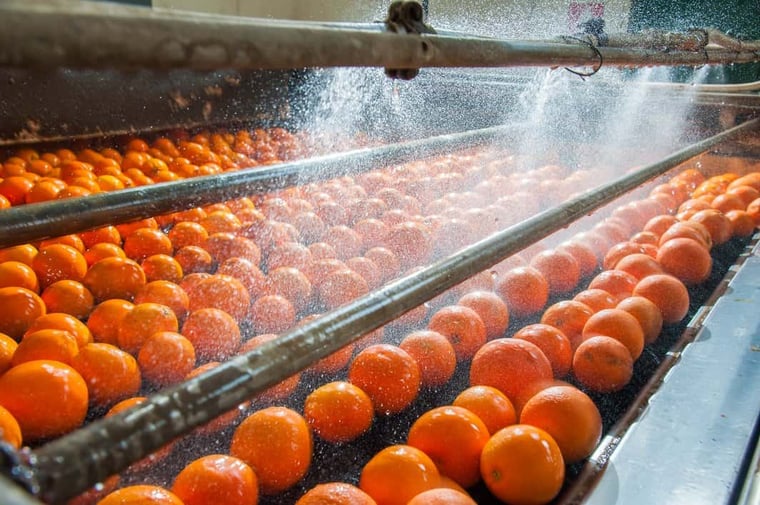Companies in the food and beverage industry can use the Power Platform to improve food safety, the supply chain and operations on the shopfloor. Here are 11 common use cases and a methodology on how to move forward.
With 85% of organizations estimated to be “cloud first” by 2025, the majority of businesses recognize the importance of the cloud. Cloud platforms offer speed, scalability and flexibility as well as save resources. These platforms have been evolving to provide industry-specific solutions and services, enabling businesses to better address their unique requirements, regulations, and workflows.
However, there are often still gaps between what standardized cloud platforms offer and what individual businesses require.
With low-code / no-code development solutions like the Microsoft Power Platform, food businesses can speed up their digital transformation journey and enable business users (citizen developers), bringing rapid innovation, cost efficiency and enhanced employee engagement.
Extract maximum value by identifying use cases
Every organization has its unique challenges, processes, and requirements that need to be addressed. While the Power Platform offers a range of capabilities, a one-size-fits-all approach may not fully address the challenges you’re facing, whether it’s workflow issues or food industry-specific demands.
By identifying your specific use cases, you can strategically allocate resources and efforts towards creating applications that directly target your pain points. This ensures the solutions developed are aligned with your organization's goals, helping you extract great value from the opportunity the Power Platform offers.
However, use case identification can be difficult for several reasons. For example, the complexity of certain processes might make it hard to envision how the Power Platform could streamline them. Resistance to change from stakeholders can also hinder progress if they don’t feel engaged or understand the reasons for change.
This underscores the benefit of getting external expertise to help with your Power Platform journey through discovery and value mapping. This teamwork will guide you in identifying your key use cases and prioritizing by significance and benefit. It enables the delivery of small, impactful projects that offer value early and progressively.

Power Platform use cases in the food industry
The Power Platform enables the creation of custom applications, automations, and workflows that address various business needs in safety, compliance, supply chain and on the shopfloor, helping fill process gaps that might not be fully covered by standard core systems.
This flexibility fosters a dynamic environment where continuous improvements can be quickly implemented, allowing you to meet the changing demands in the food industry.
Here are some of the common use cases we see from our customers:
Food safety and compliance scenarios
- HACCP* compliance – Power Apps can be created to help capture logs, perform risk assessments, and generate comprehensive audit reports that demonstrate compliance with food safety regulations. *Hazard Analytical Critical Control Points are guidelines and the basis for ISO 220000.
- Food safety audits – Apps such as digital checklists, automated report generation, and a system for tracking and managing corrective actions helps maintain and improve food safety standards.
- Product recalls – Power Apps can be built to improve the handling of recalls. This includes real-time tracking of affected products, assessing the scope of the issue, coordinating actions to mitigate risks, and generating records for compliance reporting.
- Energy monitoring and sustainability – Developing a Power App to monitor energy consumption and environmental impact allows you to identify areas for energy savings and sustainable practices.
- Food labeling compliance – Power Apps can assist in tracking ingredients, nutritional information, and packaging details, helping you meet regulatory requirements and avoid labeling-related issues.
Supply chain scenarios
- Waste management and reduction – A Power App can be built to track waste generation throughout the supply chain, offering insights into areas of waste and opportunities for reduction.
- Quality management – Develop apps to monitor materials received from suppliers, allowing you to assess quality, analyze potential risks, and take action based on real-time insights.
- Supplier audits – This app could include standardized checklists, digital documentation, and communication tools for evaluating new suppliers and ensuring they meet required standards.
Shopfloor scenarios
- Shift handover reports – streamline shift handover reports through a Power App that enables supervisors to input machine statuses, track production progress, and communicate vital updates during shift transitions.
- Issuing of PPE – a Power App improves the tracking and distribution of personal protective equipment such as masks, ensuring employees have the necessary gear to maintain workplace safety.
- Startup checks – streamline startup checks with a Power App that offers digital checklists. Operators follow these checklists to ensure equipment readiness and operational status before starting the production line, mitigating problems and keeping high product quality.

How to increase the value using the Power Platform
While the use cases above provide a general framework for food and beverage businesses, the exact integration of the Power Platform into your organization varies on several factors like company size, type of products, production processes, regulatory requirements, and unique challenges.
Navigating this intricate landscape on your own can be challenging. This is where our expertise at Columbus comes into play. Working together allows us to craft a targeted strategy that considers both your business and technical aspects, creating a project where your unique challenges are met. We can help you define a critical application, identify key stakeholders, establish necessary security measures, and recognize areas that can be managed by the business itself.
Best practice doesn't conclude with a platform setup. Sustaining success requires a continual focus on security, monitoring, and application lifecycle management. To mitigate risks, consider our assistance in establishing policies and governance frameworks for the effective operation of the Power Platform.
Our collaboration will involve workshops designed to:
- Enhance your understanding of the possibilities of low-code technology and the Power Platform for your business
- Identify potential use cases through both individual and collaborative work, pinpointing areas in your business for digitization and automation
- Prototype prioritized solutions and rank ideas based on their business value and implementation complexity
- Develop a better understanding of what’s required for building a Center of Excellence
If you want to know more, contact us for a talk.

